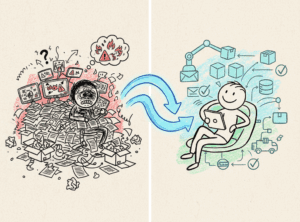The Death of the Conversion Rate?
Okay, it’s a little early to be talking about the death of the Conversion Rate. Honestly, it will realistically never die. But let’s stop talking about marginal gains. Agentic Commerce is the game-changing shift that makes everything you know about standard conversions obsolete.
Think about the leap from desktop shopping to mobile commerce—it felt huge, right? This move to autonomous agents is even bigger because it fundamentally changes who is actually doing the shopping. It’s no longer just a human clicking “Add to Cart”—it’s an AI agent performing tasks, making decisions, and executing the transaction on their behalf. Zero-click commerce is real, and it’s coming fast.
This shift instantly makes traditional e-commerce metrics—like your plain old Conversion Rate (CR)—pretty useless. Why? Because CR measures human intent and human action. If an AI agent handles the transaction from discovery all the way to checkout, that CR calculation breaks down entirely. Success in this mind-blowing new era isn’t about pretty marketing anymore—it’s about flawless technical preparation. You have to measure your operational readiness for AI agents, or you’re going to be left in the dust. We need new rules.
The future is here, and your metrics need to catch up. Here are the four essential Key Performance Indicators (KPIs) you need to focus on to stay one step ahead and thrive.
KPI 1: The Truth About Data—If the Bot Can’t Read You, You Don’t Exist
You want an AI agent to love you, right? Then you have to speak its language, and that language is clean, comprehensive data. Your Data Fill Rate is arguably the most critical readiness metric you have.
It measures the percentage of complete product information you have available for AI consumption. This means everything—descriptions, specifications, pricing, inventory availability, images, and every single piece of structured metadata.
AI agents are pure, cold logic machines. They need richly described, up-to-date data to confidently compare your product against a competitor’s. If they can’t find the size, the material, or the proper GTIN/MPN/SKU, they are not going to guess. They’re going to skip your offer and move on to the next merchant who has done their homework. A low fill rate is the same as being invisible. You have to treat your product catalogue like gold.
I recently heard a story of one company’s catalogue get systematically ignored by a major AI shopping initiative simply because they had forgotten to properly map two dozen legacy colour variants, labelling them “Misc. Blue 1.” The AI agent—a ruthless logician—was unable to confidently compare “Misc. Blue 1” to “Sky Blue” from a competitor, so it filtered the whole lot out. It was chaos, and a simple data oversight cost them a massive opportunity. The actionable path here is non-negotiable—focus on continuous data quality, ensuring every variant, every review, and every policy is machine-readable and accurate.
KPI 2: Winning the Real-Time Race—The Speed of Trust
In autonomous commerce, speed isn’t just a nice-to-have. The delay between a change in your system and its external visibility can kill a sale, wreck customer trust, and even cost you money.
Update Speed tracks the lag—the latency, if you will—between a change in your backend (like a price drop or an item selling out) and that update reaching the external AI agent interfaces.
Data freshness is utterly vital. AI agents operate at machine speed. Imagine an agent is programmed to buy an incredible pair of running shoes as soon as the price hits $75.00. Your pricing engine drops the price, but your external feed is 20 minutes behind. That 20 minutes is enough for the competitor—who has near real-time updates—to snag the sale, or worse, for the agent to purchase an item that is actually already sold out. The latter leads to a frustrated customer who then blames the AI, not you, but you’ve now harmed your trust with future AIs. Slow updates mean the agent might skip you for an easier option or present an outdated price, which means lost favour and revenue.
I once worked with a retailer where a slow inventory update caused a flash sale to be oversold by dozens of units in three hours. My job turned into an absolute nightmare of calling all these justifiably cranky customers to explain why their purchase was now vapour. I kept thinking, “If we just had a true event-driven API, I’d be sipping coffee right now instead of listening to a lecture about inefficient logistics.” The fix for slow speed is leveraging robust, well-documented APIs and event-driven integrations that let real-time inventory and pricing data synchronize instantly wherever agents fetch data. Don’t cheap out on your plumbing.
KPI 3: The Delegation Meter—How Much Shopping Are They Offloading?
We need to start monitoring the actual shift of shopping delegation from humans to machines. This is what Agent Uptake Rate is all about.
Agent Uptake Rate measures the percentage of your users or total transactions that are actively relying on AI agent assistance or autonomous shopping features. Essentially, it shows how much your customer base is trusting the machines to handle their shopping tasks.
Some reports I’ve read predict that AI agents will handle up to 20% of all e-commerce tasks by 2026. I don’t think that’s realistic to be honest, but even if we got to half of that by 2027, that’s still a massive amount of shopping volume shifting away from the traditional model of a human browsing and clicking. When you see a rising uptake rate, it signals growing trust and reliance among your customer base for delegating tasks—automatically reordering household essentials, or buying that item that hits a target price point.
A low uptake rate means your agent experience is not working, or your customers don’t feel comfortable. Maybe your system isn’t personalized enough, or maybe the usage instructions aren’t clear. The goal is to make delegation effortless—because in all honesty, people are generally happy to offload chores. Your actionable insight here is simple—if the number is low, you need to improve the agent experience to encourage customers to delegate more. Make it useable and they will come.
KPI 4: Bot Trust Score—The Final Barrier to True Autonomy
The highest barrier to truly autonomous commerce isn’t technology, it’s the customer’s willingness to delegate payment authority to an AI. This is where the Bot Trust Score comes in.
This emerging metric gauges consumer confidence in letting bots handle purchases and transactions on their behalf. You can measure it behaviorally. What is the ratio of fully automated orders versus those requiring human-in-the-loop approval? You can also use quick surveys about user comfort levels when the AI is making purchases.
Trust is the currency of this new world. If users lack confidence in the bot’s decisions—or its security—they will opt out of delegation or require explicit approval for every single transaction. That friction negates the convenience gains of agentic commerce and means you’re failing at the objective. Only about 24% of consumers are currently comfortable letting an AI agent shop for them outright. That tells you trust is the key hurdle you need to clear if you want to be successful in this space.
To raise this score, businesses must implement clear safeguards. This includes advanced security measures like the tokenization technology that major payment networks like Visa and Mastercard are putting in place—you need clear, transparent transaction logs and spending controls that are easy for the user to set. When you offer that layer of security and control, trust will follow.
The Agentic Readiness Imperative
Agentic commerce isn’t about marginal efficiency gains, it’s about shifting the burden of shopping from the customer to the machine, leading to hyper-personalized recommendations, massive time savings, and smarter deals.
Keep in mind though, these benefits are completely inaccessible if your system is not ready. By focusing on Data Fill Rate and Update Speed, you ensure technical readiness. These two metrics eliminate the risk of being ignored or skipped by autonomous agents. By monitoring Agent Uptake Rate and cultivating a high Bot Trust Score, you measure customer comfort and adoption, reinforcing the trust required for true delegation.
Success in the future depends entirely on measuring what truly matters—your system’s preparedness and your customers’ confidence in delegating control. These four KPIs provide the actionable roadmap for securing your place in the fantastic future of autonomous commerce.





